If you are just getting into saltwater aquariums, and more particularly—coral reef aquariums, then you might be wondering what this term is all about, ‘What is a reef ready aquarium?’. Don’t worry, I was just the same when I first heard about it, and I wish I had known about this term before I built my very first reef tank!
Reef ready aquariums are a plug-&-play aquarium system. They come from the manufacturers with a drilled tank, pre-installed overflow box, drain pipe, sump, return pipe, and all the plumbing fittings to allow for quick and easy installation by the owner.
As more and more people look at installing a saltwater aquarium in their homes and offices the Reef Ready aquarium system makes it a simple process thanks to the many incredible aquarium packages available from the worlds leading aquarium manufacturers.
They allow owners to install very nice, high-quality aquariums with very few tools and DIY skills making them a very popular choice among beginners especially!
For more information on everything you need to know why reef ready aquariums are great for the beginner to saltwater, please read on…
What Does Reef Ready Mean?
To understand what is so different about reef ready aquariums, it is vital to have a good grasp of how they work and what their main purpose is.
Reef ready aquariums (a.k.a RR aquariums or RR tanks) are aquariums that have had holes drilled in them and have a built-in overflow, located in the middle or the corner of the back glass. Depending on the type of overflow, the hole/s are drilled in the rear or bottom panes of the tank in the factory.
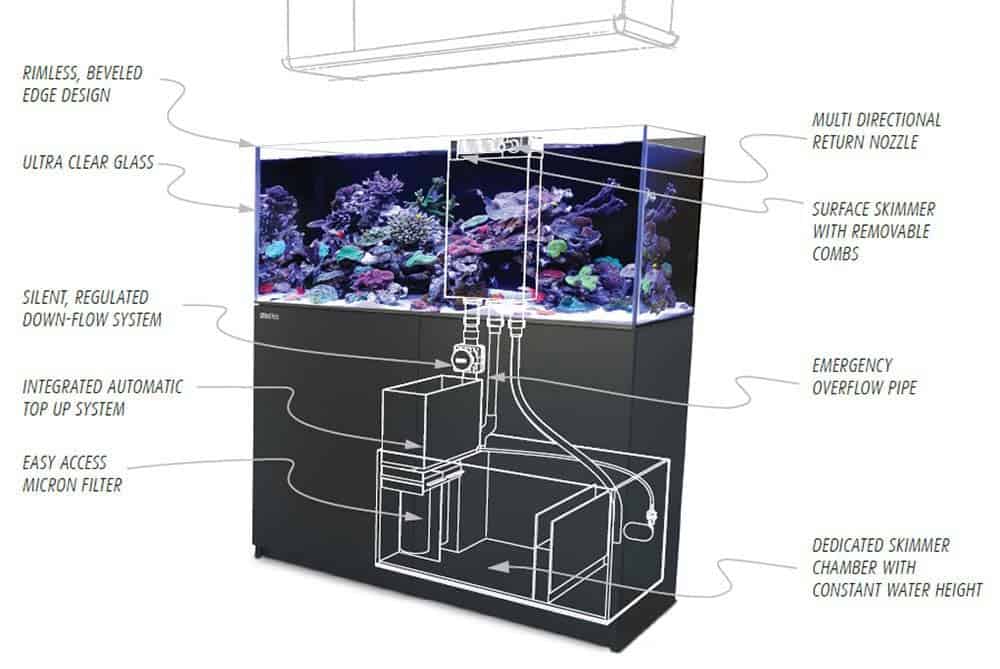
Typically, reef ready aquariums come directly from the manufacturer and will have the necessary plumbing already installed inside the tank (In other words, reef ready tanks are almost plug-and-play), or will come with all the parts as a kit with simple instructions on how to plumb it all together.
Reef ready aquariums are typically used for saltwater but there is no reason that they cannot be used for freshwater too. By hiding the filtration and the heater in the sump under the tank (more on this later), it will give a beautiful, uncluttered look to the aquarium, no matter what kind of water type is used.
How Do Reef Ready Aquariums Work?
The main reason reef ready tanks exist is to give owners the chance to have a stunning aquarium with no equipment being shown. In today’s saltwater aquariums the only equipment that is regularly seen are the wavemakers needed to create strong water flow that corals require to feed and stay healthy.
To create stunning, uncluttered showpieces, the life support equipment must be hidden from view. This is where a drilled aquarium comes in, but for those who have no DIY tools, skills, or desire the pre-made reef ready kits are a fantastic choice.
The way in which a reef ready tank works is very simple:
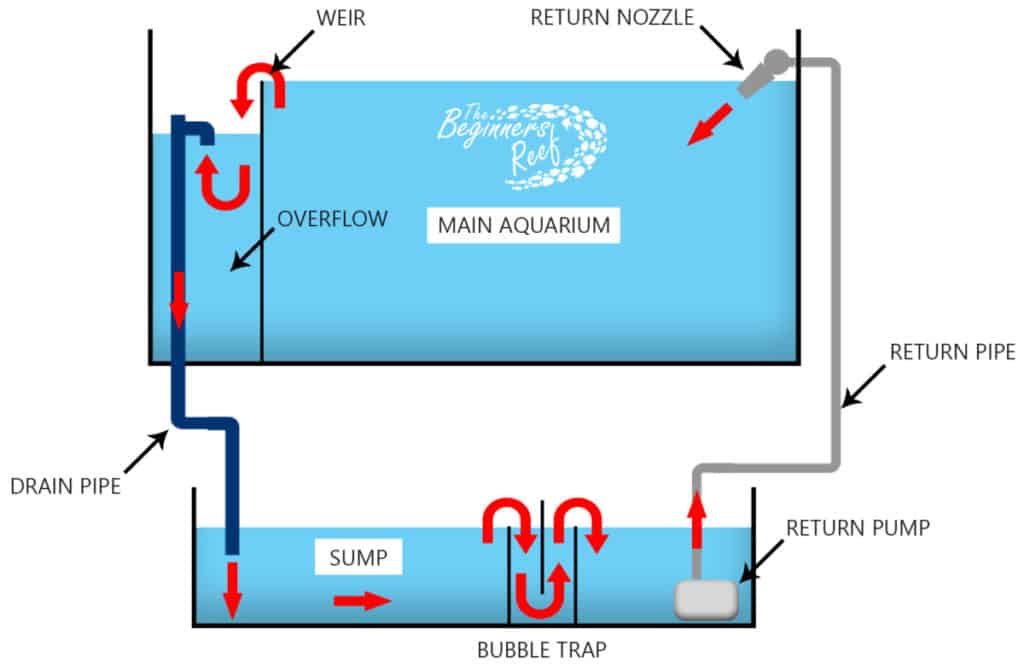
Water is filled into the main aquarium, when the water inside the tank reaches the overflow, also known as a weir, it will flow over the teeth like the anti-flood hole you will find in most bathroom sinks.
The overflow is used to maintain a constant water weight within the main aquarium. It’s like a dam on a reservoir. Once the water flows into the overflow, it then drains down through the drainpipe into a tank sitting below the aquarium, hidden in the stand/cabinet. This lower tank is called the ‘Sump’.
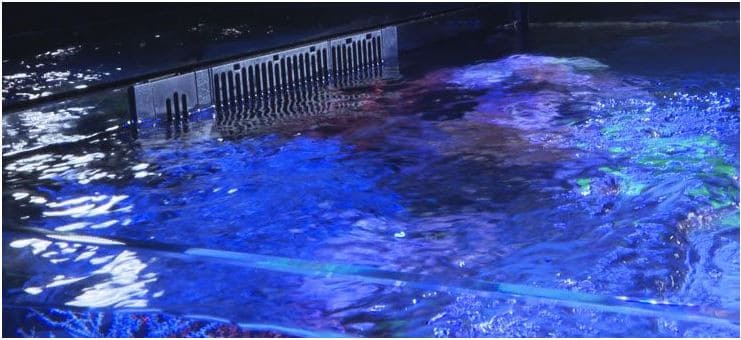
Inside the sump, the water will pass through various chambers where it will get filtered and heated/cooled (providing the necessary equipment has been installed) and then reaches a water pump called the ‘Return Pump.
The job of the return pump is to pump the water back up to the main aquarium via the ‘Return Pipe’. The water exits the return pipe via a nozzle or nozzles to allow the owner to direct the flow to their liking.
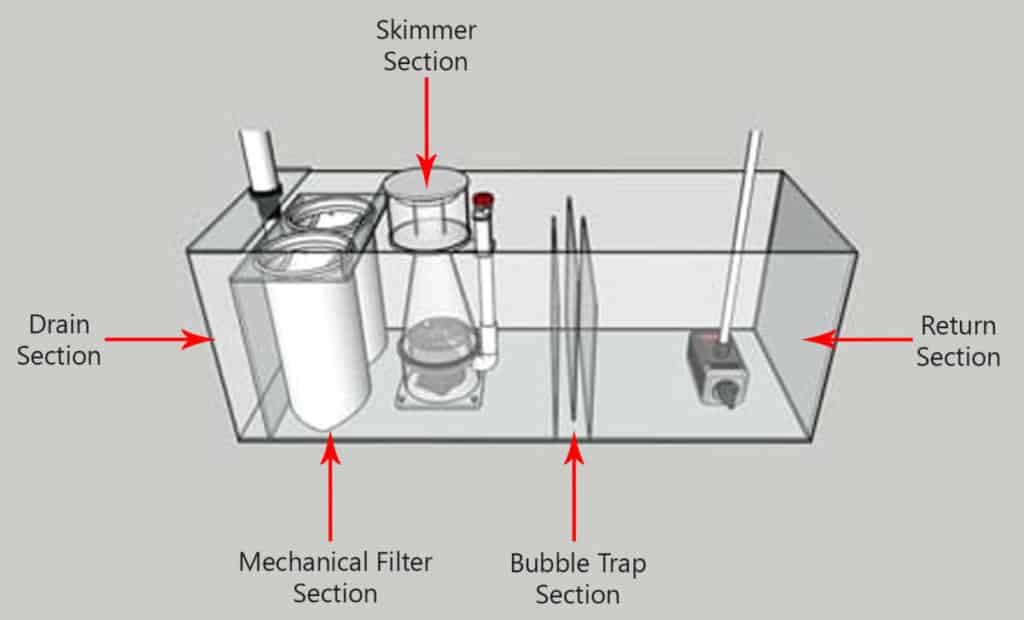
This then completes the water cycle. As water pumps into the aquarium, water is displaced into the overflow, down it drains, gets filtered, and pumped back – simple.
What Components Are Needed for a Reef Ready Aquarium?
A reef ready aquarium needs several different components to work properly. Some reef ready aquariums can be quite complex, but most are very basic to keep it simple!
The basic components of a reef ready aquarium are:
- A built-in overflow
- Bulkheads to pass the pipes through the glass panes
- A drain pipe
- A sump
- A return pump
- A return pipe
- A return nozzle
Usually, most reef ready aquariums will have the overflow, drain pipe, and the return pipe already installed in the tank (including the bulkheads and sometimes strainers – Strainers help prevent fish and critters going into the drain pipe). However, some models may have only predrilled holes, with the rest of the equipment typically sold separately.
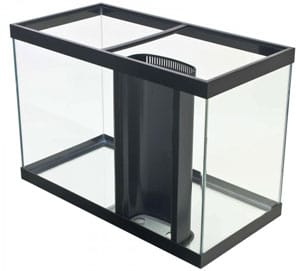
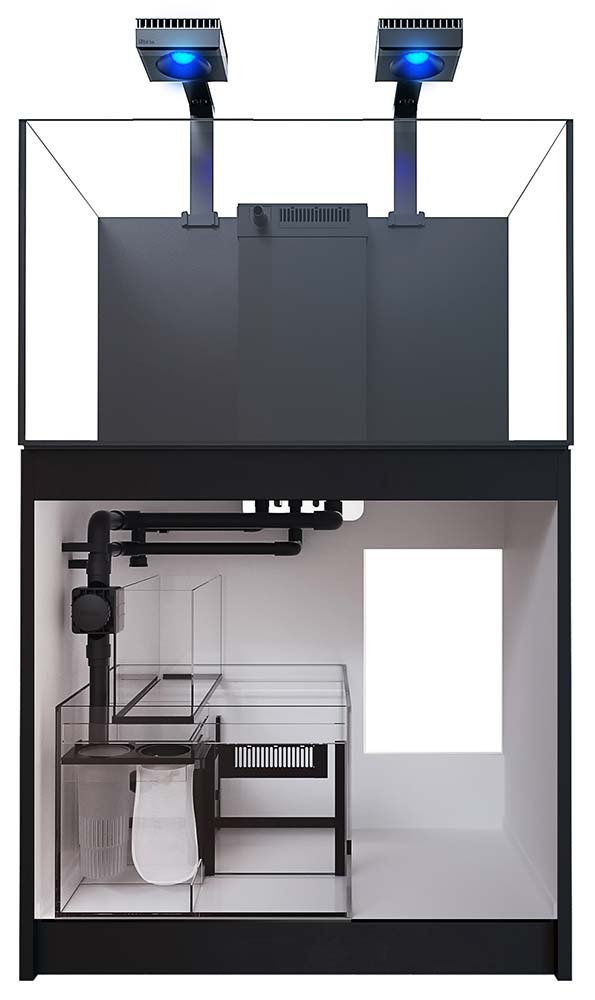
The sump, the pipes or hoses between the display tank, the sump, and other necessary equipment like the return pump are usually not included in a reef-ready tank and should be purchased separately.
But, some of the latest reef ready kits have been tailored to the absolute beginner and come with everything they need, however, they can seem costly at first glance. But once you price out all the equipment that is included it’s pretty competitive!
Do All Reef Tanks Need to Be Reef Ready?
One of the questions many beginners will ask themselves is whether they really need a reef ready tank, especially when seeing the cost!
Here’s the thing…
Not all reef tanks need to be reef ready! Non-reef ready aquariums do not have any holes drilled into them or a built-in overflow, which makes using them a little more challenging, but not impossible.
Non-reef ready tanks (also known as just a standard tank) will often have to be drilled or used with an overflow box if you wish to hide all the life support equipment.
The only other option is an AIO: All-In-One aquarium – For more information on these types of aquarium see the link in the ‘Further Reading Section at the end of the article.
Reef Ready Tank vs. Overflow Box
If you have a non-reef ready tank and do not want to drill it, then an option is to use an item called an Overflow Box. These devices sit over the top rim of the aquarium and use a siphon to drain water from the tank and into the sump.
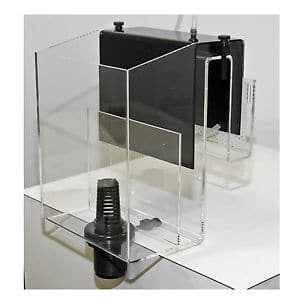
Compared to reef ready tanks, overflow boxes are typically noisier, and if not properly set up, can allow water to flood over the top of the aquarium if they lose siphon and the return pump keeps pumping.
Power returning to the tank after an outage is usually the most common times these flood!
Although hang on back (HoB) overflow boxes do work as intended for many people, they are avoided by most aquarists. I cannot recommend these to anyone as I have dealt with too many flooded homes from these losing their siphon.
Other issues with HoB overflow boxes are they usually cannot handle good amounts of flow, so the water turnover rate of a large aquarium is too slow and they are not visually appealing.
Reef Ready vs. Drilled Tank
When it comes to non-reef ready tanks, aquarists will nearly always prefer to drill a small hole in the top section of the tank’s back or side panel. This is what I did on my current reef tank:
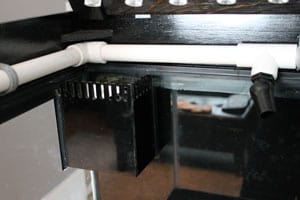
Most tanks can be drilled on the side and back panes only, because the bottom panel is made from tempered glass, and attempting to drill it will immediately shatter it.
The drilled hole is used for the overflow to connect to the drain pipe via a bulkhead. When drilling a hole you will need to factor in its location as the height of the drainpipe within the overflow will dictate the height of the overflow in the tank. This then dictates the height of the water level in the main tank.
When drilling a tank (which is very easy, but can be stressful) most aquarists only drill a hole or holes required for the overflow and drain pipes. Most do not drill a hole for the return pipe as it is easy to just bring the pipe over the top rim of the tank.
Drilling can be a little nerve-racking because there is never a guarantee that the aquarium won’t break, but if you are dealing with a standard non-reef ready aquarium, drilling is usually the best option. There are many great YouTube videos on how to drill aquariums.
When it comes to second-hand drilled aquariums used as reef tanks, people can often refer to them as reef-ready. However, these should not be confused with the standard reef ready aquariums that come with everything predrilled and installed from the manufacturer.
Simply, drilled tanks mean you have to do the work to get them the same as a manufacturer reef ready system.
Are Reef Ready Aquariums Worth It?
In my opinion, for a person wanting to set up a larger (over 50 gallons) aquarium then a pre-made reef ready aquarium is a fantastic option!
Reef ready aquariums are more expensive than standard aquariums however, since the reef ready aquariums already have the necessary holes predrilled, the overflow/s installed, and all the plumbing either semi-assembled or in a kit they make installation a breeze!.
In most cases, the less hassle is worth the extra expense! Trust me!!
On top of that, you will be dealing with a lot fewer problems overall and in the beginning, you will have a steep learning curve as it is! The integration with the sump is going to be a doddle, and in most cases, having a sump is definitely worth it as it gives you more freedom and makes the maintenance a lot easier because you have more space to work with.
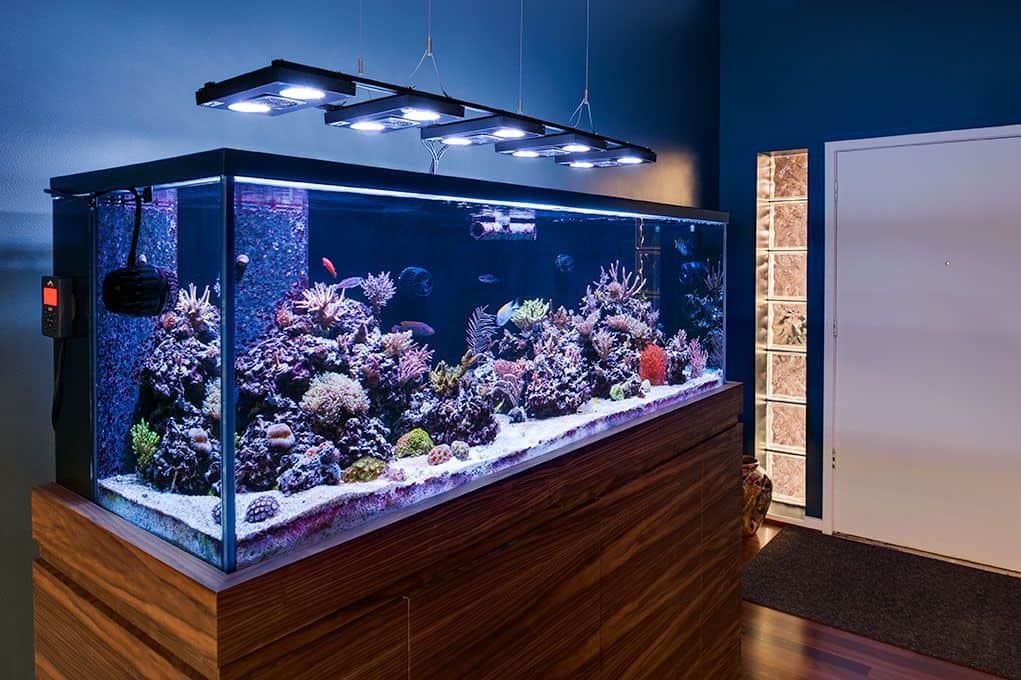
The sump also allows you a much greater selection of life support equipment that you will need because this hobby is predominantly geared around aquariums with sumps. Depending on what is included in the reef ready bundle you will need at the absolute minimum:
- A Return Pump
- A Protein Skimmer (See Article in Further Reading Section)
- A Heater
Reef Ready Aquarium Recommendations
Typically, the 40 to 90-gallon aquariums are a great size range for a beginner. In my opinion, they are not too big which costs a lot, and not small enough to fluctuate in their stability.
Many Beginners often start with 10 to 75-gallon aquariums, while experienced reefers often go with larger reef tanks of 125 to upwards of 180 gallons. My current 75 gallon is a perfect size for my home, but when we move house soon, I will be going much larger!
I love the reef ready ranges from Red Sea, Waterbox and Innovative Marine.
If you wanted to see a great selection of stunning Reef Ready Aquariums please be sure to check them out
Here at AquariumSpecialty.com
Further Reading
The following articles may help you too:

